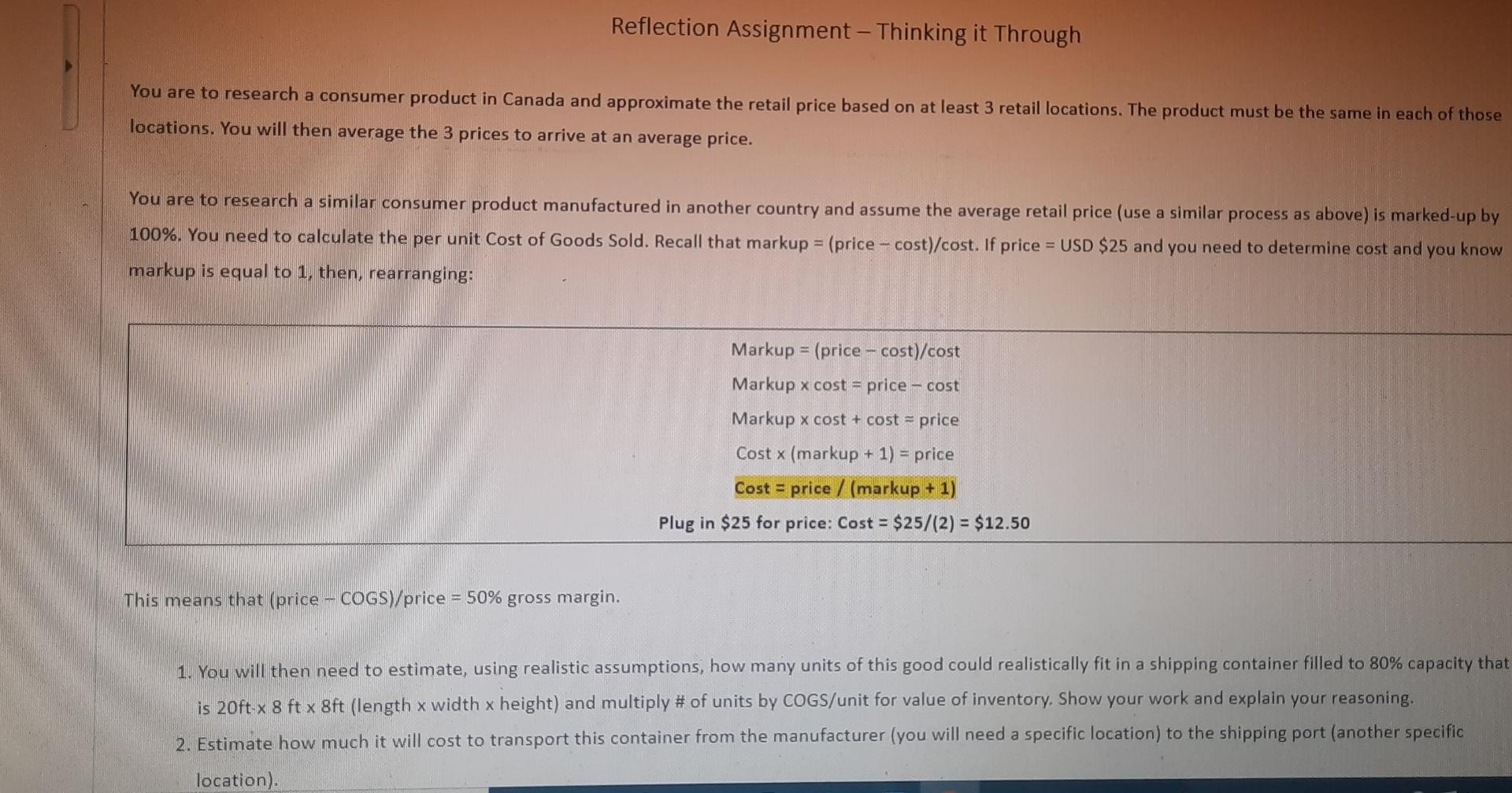Answered step by step
Verified Expert Solution
Question
1 Approved Answer
Reflection Assignment - Thinking it Through You are to research a consumer product in Canada and approximate the retail price based on at least 3


Reflection Assignment - Thinking it Through You are to research a consumer product in Canada and approximate the retail price based on at least 3 retail locations. The product must be the same in each of those locations. You will then average the 3 prices to arrive at an average price. You are to research a similar consumer product manufactured in another country and assume the average retail price (use a similar process as above) is marked-up by 100%. You need to calculate the per unit Cost of Goods Sold. Recall that markup = (price cost)/cost. If price = USD $25 and you need to determine cost and you know markup is equal to 1, then, rearranging: Markup = (price - cost)/cost Markup x cost = price - cost Markup x cost + cost = price Cost x (markup + 1) = 1 = price Cost = price/(markup + 1) Plug in $25 for price: Cost = $25/(2) = $12.50 This means that (price - COGS)/price = 50% gross margin. 1. You will then need to estimate, using realistic assumptions, how many units of this good could realistically fit in a shipping container filled to 80% capacity that is 20ft-x 8 ft x 8ft (length x width x height) and multiply # of units by COGS/unit for value of inventory. Show your work and explain your reasoning. 2. Estimate how much it will cost to transport this container from the manufacturer (you will need a specific location) to the shipping port (another specific location). This means that (price - COGS)/price = 50% gross margin. 1. You will then need to estimate, using realistic assumptions, how many units of this good could realistically fit in a shipping container filled to 80% capacity that is 20ft x 8 ft x 8ft (length x width x height) and multiply # of units by COGS/unit for value of inventory. Show your work and explain your reasoning. 2. Estimate how much it will cost to transport this container from the manufacturer (you will need a specific location) to the shipping port (another specific location). 3. Estimate how much it will cost to ship overseas to Canada's port (a specific port) (we will ignore cargo insurance for this assignment). 4. Estimate how much customs will charge for duties (Use HS Code). 5. Estimate how much it will cost to transport to a large distributor or warehouse in Canada (you will need a specific location). 6. Lastly, you will need to estimate the size (quantity) of a retail order and how much this will cost to ship to the final retail destination. 7. Calculate the per unit cost and compare this to the price in the Canadian market of a similar product. Precision is not the goal here. The goal is to think through the steps and estimate the costs using reasonable figures (labour rate x hours or depreciation rate - try to think of all costs incurred to complete the activity or task - i.e. transportation has labour, truck, materials like gas, etc.). Again, we are approximating using reasonable estimates. Remember that when shipping up until the distributor or the warehouse, all costs will be distributed on a per unit basis equally and added to COGS/(total shipping container units). When the shipping crate is divided into smaller retail orders, you will need to spread the shipping cost across fewer items and add this to the COGS/(total package units) as well. Reflection Assignment - Thinking it Through You are to research a consumer product in Canada and approximate the retail price based on at least 3 retail locations. The product must be the same in each of those locations. You will then average the 3 prices to arrive at an average price. You are to research a similar consumer product manufactured in another country and assume the average retail price (use a similar process as above) is marked-up by 100%. You need to calculate the per unit Cost of Goods Sold. Recall that markup = (price cost)/cost. If price = USD $25 and you need to determine cost and you know markup is equal to 1, then, rearranging: Markup = (price - cost)/cost Markup x cost = price - cost Markup x cost + cost = price Cost x (markup + 1) = 1 = price Cost = price/(markup + 1) Plug in $25 for price: Cost = $25/(2) = $12.50 This means that (price - COGS)/price = 50% gross margin. 1. You will then need to estimate, using realistic assumptions, how many units of this good could realistically fit in a shipping container filled to 80% capacity that is 20ft-x 8 ft x 8ft (length x width x height) and multiply # of units by COGS/unit for value of inventory. Show your work and explain your reasoning. 2. Estimate how much it will cost to transport this container from the manufacturer (you will need a specific location) to the shipping port (another specific location). This means that (price - COGS)/price = 50% gross margin. 1. You will then need to estimate, using realistic assumptions, how many units of this good could realistically fit in a shipping container filled to 80% capacity that is 20ft x 8 ft x 8ft (length x width x height) and multiply # of units by COGS/unit for value of inventory. Show your work and explain your reasoning. 2. Estimate how much it will cost to transport this container from the manufacturer (you will need a specific location) to the shipping port (another specific location). 3. Estimate how much it will cost to ship overseas to Canada's port (a specific port) (we will ignore cargo insurance for this assignment). 4. Estimate how much customs will charge for duties (Use HS Code). 5. Estimate how much it will cost to transport to a large distributor or warehouse in Canada (you will need a specific location). 6. Lastly, you will need to estimate the size (quantity) of a retail order and how much this will cost to ship to the final retail destination. 7. Calculate the per unit cost and compare this to the price in the Canadian market of a similar product. Precision is not the goal here. The goal is to think through the steps and estimate the costs using reasonable figures (labour rate x hours or depreciation rate - try to think of all costs incurred to complete the activity or task - i.e. transportation has labour, truck, materials like gas, etc.). Again, we are approximating using reasonable estimates. Remember that when shipping up until the distributor or the warehouse, all costs will be distributed on a per unit basis equally and added to COGS/(total shipping container units). When the shipping crate is divided into smaller retail orders, you will need to spread the shipping cost across fewer items and add this to the COGS/(total package units) as well
Step by Step Solution
There are 3 Steps involved in it
Step: 1

Get Instant Access to Expert-Tailored Solutions
See step-by-step solutions with expert insights and AI powered tools for academic success
Step: 2

Step: 3

Ace Your Homework with AI
Get the answers you need in no time with our AI-driven, step-by-step assistance
Get Started


